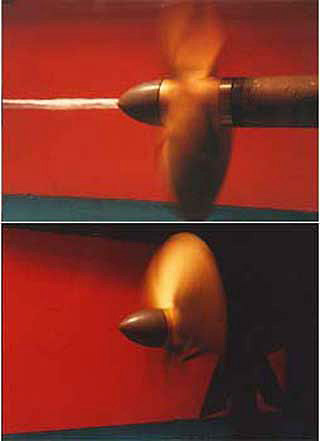
Top: A propeller operating alone produces a substantial cavitating hub vortex. Bottom: The addition of a pre-swirl stator cancels out the propeller vortex. (Photos courtesy of Justin E. Kerwin. Used with permission.)
Instructor(s)
Prof. Paul D. Sclavounos
Prof. Richard Kimball
MIT Course Number
2.23
As Taught In
Spring 2007
Level
Graduate
Course Description
Course Features
- Assignments: problem sets with solutions
- Assignments: programming (no examples)
- Exams (no solutions)
Course Highlights
This course includes a set of popular propeller design notes by MIT Professor Justin E. Kerwin in the course notes section.
Course Description
This course develops the theory and design of hydrofoil sections, including lifting and thickness problems for sub-cavitating sections, unsteady flow problems, and computer-aided design of low drag cavitation-free sections. It also covers lifting line and lifting surface theory with applications to hydrofoil craft, rudder, control surface, propeller and wind turbine rotor design. Other topics include computer-aided design of wake adapted propellers; steady and unsteady propeller thrust and torque; performance analysis and design of wind turbine rotors in steady and stochastic wind; and numerical principles of vortex lattice and lifting surface panel methods. Projects illustrate the development of computational methods for lifting, propeller and wind turbine flows, and use of state-of-the-art simulation methods for lifting, propulsion and wind turbine applications.
Other Versions
Other OCW Versions
Archived versions: ![]()


